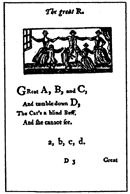 | |||||
|
Who was Mother Goose? Many she's and he's—different writers—in different times. The term has been traced to Loret's 1650 La Muse Historique in which appeared the line, Comme un conte de la Mere Oye ("Like a Mother Goose story"). Two French Queen Berthas have been conjectured as a "Mother Goose" but there is no traceable evidence that either was the reference in Loret's remarks. In 1697 Charles Perrault used the phrase in a published collection of eight fairy tales which included "The Sleeping Beauty," "Little Red Riding Hood," "Cinderella," "Bluebeard," and others. Although the book was titled, (translated from French) Histories and Tales of Long Ago, with Morals, the frontispiece showed an old woman spinning and telling stories, with a placard on the page which bore the words Contes de la Mere l'Oye (Tales of My Mother the Goose). Perrault thereby set the stage for the name to become a household word. The first English appearance of the name is sometimes erroneously credited to Robert Powel, who presented puppet shows between 1709 and 1711. An 1828 article misprinted as "Mother Goose," one of his scripts actually titled "Mother Lowse." The single most important promoter of the designation of Mother Goose as writer of children's rhymes was John Newbery. With his adoption of her name for a collection of mostly traditional rhymes, he usurped her former alliance with the tales. The date for publication of this important edition is agreed by scholars to be about 1765 (1760-1766). Mother Goose's Melody: or Sonnets for the Cradle was a little volume, believed to have been edited by Oliver Goldsmith, with Goldsmith's decidedly unchildlike "maxims" as footnotes. Newbery's book was widely pirated and numerous editions were reprinted in England, and in America at Boston and New York, with additional rhymes. The designation "Mother Goose Rhymes" took hold. All documentation clearly disputes the legend of a supposed "Boston Mother Goose." Suddenly in 1860, a claim was made that the originator of the tales was one Elizabeth Goose, great-grandmother of publisher Isaiah Thomas's wife. Scholars have searched fruitlessly for the supposed "ghost volume" which simply does not appear to exist. In addition, all the dates connected with the Boston claim are "off." But despite the facts, nursery-rhyme pilgrims continue to visit the presumed gravesite to pay homage—presumed, because Elizabeth Goose's grave has no marker, and the misled pilgrims worship instead at the headstone of a "Mary Goose." The fact is that "Mother Goose" rhymes are from many sources, passed down in folklore fashion (some even written by famous authors) and perpetuated by publishers, frequently without author attribution. So, origins of Mother Goose terminology are vague—and authorship of the verses is known to be varied—yet, we all know that "Mother Goose" is—somehow—real. — condensed from material in Mother Goose: From Nursery to Literature (McFarland Pub.) by Gloria T. Delamar | ||||
[ Mother Goose Society Homepage ] | |||||

